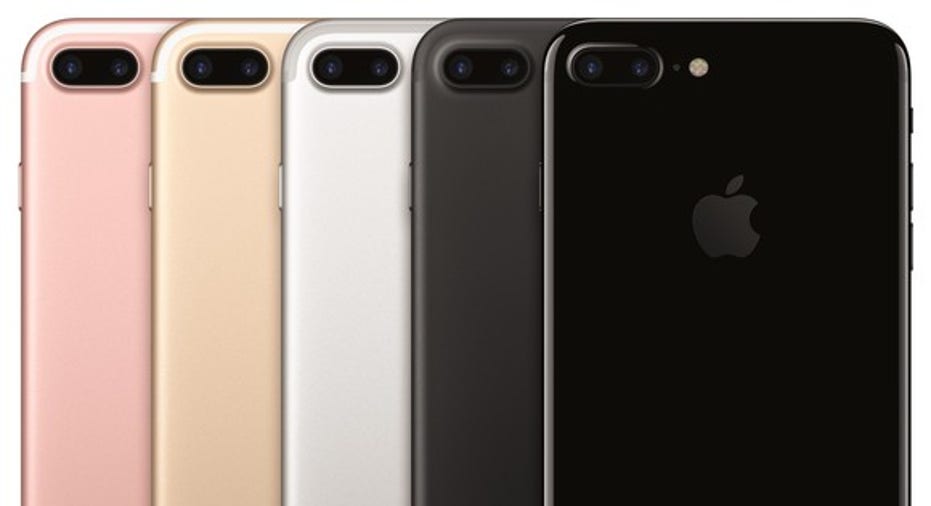1 Way Apple Inc. Can Drive Smartphone Average Prices Up

Apple's iPhone 7 Plus. Image source: Apple.
At this point, it's extremely difficult to get hold of an Apple (NASDAQ: AAPL) iPhone 7 Plus in either black or jet black. In contrast, finding most models of the iPhone 7 in stores isn't terribly difficult. It's not entirely clear why the iPhone 7 Plus is in relatively short supply compared with the iPhone 7, but I suspect that part of it is due to a customer shift from the 4.7-inch iPhone model to the larger 5.5-inch iPhone 7 Plus.
It's not hard to see why customers might be interested in the bigger phone. The display is sharper, packing a pixel density of 401 pixels per inch compared with the 326 of the smaller one, although this has been the case for the past couple of generations. And, perhaps more importantly, the larger one has the differentiated dual-camera setup that enables buyers to use a true optical zoom.
To put it bluntly, the iPhone 7 Plus is simply a better phone than the iPhone 7, and it may be the case that an increasing number of iPhone buyers are willing to pay more to get a better product.
Going forward, I expect Apple to continue to differentiate the larger smartphone from the smaller one in a bid to drive an even richer product mix -- pushing Apple's average selling prices, gross margin dollars, and ultimately profit margins up.
Where Apple can profitably differentiate
The areas in which Apple is likely to differentiate its larger iPhone from its smaller one are in areas that matter a lot to customers. The camera is a big one, as is the display -- not so coincidentally the two areas in which the company differentiates its smaller and larger iPhones today.
A report from the generally reliable KGI Securities analyst Ming-Chi Kuo, via MacRumors, claimed that with the next iPhone, Apple intends to keep the dual-lens camera unique to the larger model. Given that the dual-lens camera seems to be a compelling selling point for the iPhone 7 Plus over the iPhone 7, further enhancing the features and functionality of the dual lens camera with the iPhone 8 Plus seems like a smart move.
Additionally, according to a report from Nikkei, Apple is planning to launch not two, but three new iPhones next year: a 4.7-inch model, a 5.5-inch model, and a 5.5-inch "or larger" model "equipped with a screen bent on two sides."
Moreover, the report claims that only the highest-end model will include a curved OLED display; the other two will stick with liquid crystal displays similar to the ones found on today's iPhone 7, though this isn't necessarily a bad thing, given how high quality the iPhone 7 and 7 Plus displays are.
The point, though, is that Apple seems to be realizing there are customers who will pay more as long as they receive real value in return. The iPhone 7 Plus, for example, is $20 more expensive than prior Plus models, but that doesn't seem to be stopping demand from outpacing supply at the moment. I suspect that next year's OLED-equipped iPhone will be priced at quite a premium, perhaps starting at $869, and that it will still do very well in the marketplace.
Investment takeaway
Apple now has the resources to develop multiple versions of its products to target different price points. We've seen Apple go lower with the iPhone SE, and we've seen it push pricing of the iPhone 7 Plus up relative to the prior-generation iPhone 6s Plus and its predecessor, the iPhone 6 Plus. We've even seen Apple restrict the jet-black finish to higher-storage-tier iPhones.
I believe that Apple has a good opportunity to sell an increasingly rich mix of products over the next couple of years, through feature differentiation in higher-end models. Assuming constant units, this approach should translate into both higher units, gross margin, and ultimately profits.
Should a more aggressive segmentation strategy also drive up overall unit shipments, that would be just gravy for the iDevice maker.
A secret billion-dollar stock opportunity The world's biggest tech company forgot to show you something, but a few Wall Street analysts and the Fool didn't miss a beat: There's a small company that's powering their brand-new gadgets and the coming revolution in technology. And we think its stock price has nearly unlimited room to run for early in-the-know investors! To be one of them, just click here.
Ashraf Eassa has no position in any stocks mentioned. The Motley Fool owns shares of and recommends Apple. The Motley Fool has the following options: long January 2018 $90 calls on Apple and short January 2018 $95 calls on Apple. Try any of our Foolish newsletter services free for 30 days. We Fools may not all hold the same opinions, but we all believe that considering a diverse range of insights makes us better investors. The Motley Fool has a disclosure policy.